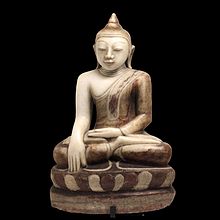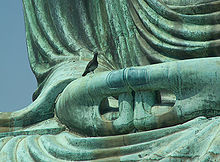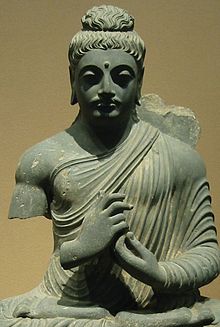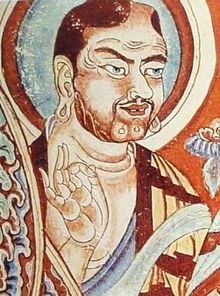- Mudra
-
This article is about the use of mudrā in Indic religion. For mudra as used in Indian classical music, see Mudra (music).
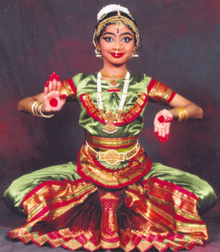 Bharatnatyam dancer portraying Hindu goddess Lakshmi with her characteristic mudrās
Bharatnatyam dancer portraying Hindu goddess Lakshmi with her characteristic mudrās
A mudrā (English: /muːˈdrɑː/ (
 listen); Sanskrit: मुद्रा "seal", "mark", or "gesture") is a symbolic or ritual gesture in Hinduism and Buddhism.[1] While some mudrās involve the entire body, most are performed with the hands and fingers. A mudrā is a spiritual gesture and an energetic seal of authenticity employed in the iconography and spiritual practice of Indian religions and traditions of Dharma and Taoism.
listen); Sanskrit: मुद्रा "seal", "mark", or "gesture") is a symbolic or ritual gesture in Hinduism and Buddhism.[1] While some mudrās involve the entire body, most are performed with the hands and fingers. A mudrā is a spiritual gesture and an energetic seal of authenticity employed in the iconography and spiritual practice of Indian religions and traditions of Dharma and Taoism.One hundred and eight mudras are used in regular Tantric rituals.[2]
In yoga, mudrās are used in conjunction with pranayama (yogic breathing exercises), generally while seated in Vajrasana pose, to stimulate different parts of the body involved with breathing and to affect the flow of prana in the body.
A brain research paper published in the National Academy of Sciences in November 2009, demonstrated that hand gestures stimulate the same regions of the brain as language.[3]
Contents
Nomenclature and etymology
The Chinese translation is yin (Chinese: 印; pinyin: yìn) or yinxiang (Chinese: 印相; pinyin: yìnxiàng). The Japanese and Korean spelling is "in".
Iconography
Mudrā is used in the iconography of Hindu and Buddhist art of the Indian subcontinent and described in the scriptures, such as Nātyaśāstra, which lists 24 asaṁyuta ("separated", meaning "one-hand") and 13 saṁyuta ("joined", meaning "two-hand") mudrās. Mudrā positions are usually formed by both the hand and the fingers. Along with āsanas ("seated postures"), they are employed statically in the meditation and dynamically in Nāṭya practice of Hinduism. Each mudrā has a specific effect on the practitioner. Common hand gestures are to be seen in both Hindu and Buddhist iconography. In some regions, for example Thailand and Laos, these are different from each other, but related iconographic conventions are used.
According to Jamgon Kongtrul in his commentary on the Hevajra Tantra, the symbolic bone ornaments (Skt: aṣṭhiamudrā; Tib: rus pa'i rgyanl phyag rgya) are also known as "mudra" or "seals".[4]
Indian Classical Dance
See also: List of Mudras in Indian Classical DanceIn Indian classical dance the term "Hasta Mudra" (hasta is Sanskrit for hand) is used. The Natya Shastra describes 24 mudra's, while the Abhinaya Darpana gives 28 in total.[7] In all the forms of Indian classical dance the mudras are similar, though the names and uses vary. There are 28 (or 32) root mudras in Bharatanatyam, 24 in Kathakali and 20 in Odissi. These root mudras are combined in different ways, like one hand, two hands, arm movements, body and facial expressions. In Kathakali, which has the greatest number of combinations, the vocabulary adds up to circa 900. Sanyukta mudras are mudras that use both hands, and asanyukta mudras are mudras that use only one hand words.[8]
Yogic mudrās
The main source of Mudra are Gherandya Samhita, Hathyoga Pradipika. Gherandya Samhita is written by Sage Gherandya and Hathyoga Pradipika is written by Swami Pt. Swatmaram from Nath Tradition. Thenafter was more work on those topic through Swami Satyanand Saraswati. He was the founder of Bihar School of Yoga. Mudrās are a fundamental form of yoga practice, e.g. the most famous book published by the Bihar School of Yoga is called Asana, Pranayama, Mudrā, Bandha.
Basic mudrā: Chin Mudrā
Thumb and forefinger on each of both hands join as a zero. The rest of the fingers are extended, with the middle finger touching the non-folded part of the forefinger. The hands are placed palms-down on the thighs while sitting in Vajrasana. This mudrā activates the diaphragm, making for deep "stomach-breathing", as the diaphragm pushes out the internal organs when it descends towards the pelvis on inhalation. Slow rhythmic breathing in a 5-2-4-2 rhythm (5 being the exhalation, and 4 is the inhalation) makes prana flow in the pelvis and in the legs.
Basic mudrā: Chinmaya Mudrā
Thumb and forefinger are the same as Chin Mudrā. The rest of the fingers are folded into a fist. The non-folded part of the forefinger and the middle finger should still be touching. Like in Chin Mudrā, the hands are placed palms-down on the thighs while sitting in Vajrasana. This mudrā activates the ribs, making them expand sideways on inhalation. Slow rhythmic breathing in a 5-2-4-2 rhythm (5 being the exhalation, and 4 is the inhalation) makes prana flow in the torso and in the throat.
Basic mudrā: Adi Mudrā
Thumb is folded into the palm, touching the base of the small finger. The rest of the fingers are folded over the thumb, to create a fist. Like in Chin Mudrā, the hands are placed palms-down on the thighs while sitting in Vajrasana. This mudrā activates the pectoral muscles, making the chest expand forward on inhalation. Slow rhythmic breathing in a 5-2-4-2 rhythm (5 being the exhalation, and 4 is the inhalation) makes prana flow in the throat and in the head.
Basic compact mudrā: Brahma Mudrā
Palms are in Adi Mudrā, but the inside of the palms face upwards and are located at the level of the navel, with the left and right knuckles and first finger joints touching. This is done while sitting in Vajrasana. Breathing becomes full: in inhalation, the diaphragm descends, the ribs then expand, and then the pectoral muscles move forward. Exhalation works in the same order, which creates a "wave" or ripple effect. Slow rhythmic breathing in a 5-2-4-2 rhythm (5 being the exhalation, and 4 is the inhalation) makes prana flow in the entire body.
Advanced compact mudrā: Prana Mudrā
A complicated Mudrā combining hand gestures, synchronized movement from gesture to gesture within the breath cycle, and meditation. The mudrā is practiced sitting in Siddhasana. Even a single breath cycle of this Mudrā can significantly stimulate the body. It is described in the book, Theories of the Chakras, by Hiroshi Motoyama.
Common Buddhist mudrās
Abhaya Mudrā
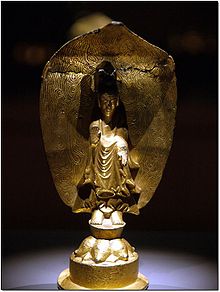 Korea's National Treasure no. 119. The right hand shows the fear-not gesture, while the left is in the Varada (wish-granting gesture).
Korea's National Treasure no. 119. The right hand shows the fear-not gesture, while the left is in the Varada (wish-granting gesture).
The Abhaya mudrā ("mudrā of no-fear") represents protection, peace, benevolence, and dispelling of fear. In the Theravāda, it is usually made with the right hand raised to shoulder height, the arm bent and the palm facing outward with the fingers upright and joined and the left hand hanging down while standing. In Thailand and Laos, this mudrā is associated with the walking Buddha, often shown having both hands making a double Abhaya mudrā that is uniform. The mudrā was probably used before the onset of Buddhism as a symbol of good intentions proposing friendship when approaching strangers. In Gandhāra art, it is seen when showing the action of preaching. It was also used in China during the Wei and Sui eras of the 4th and 7th centuries. The gesture was used by the Buddha when attacked by an elephant, subduing it as shown in several frescoes and scripts. In Mahāyāna, the northern schools' deities often paired it with another mudrā using the other hand. In Japan, when the Abhaya mudrā is used with the middle finger slightly projected forward, it is a symbol of the Shingon sect. (Japanese: Semui-in; Chinese: Shiwuwei Yin)[citation needed]
Bhumisparsha Mudrā
This gesture calls upon the earth to witness Shakyamuni Buddha's enlightenment at Bodh Gaya. A seated figure's right hand reaches toward the ground, palm inward.
Dharmacakra Mudrā
The Dharmacakra mudrā represents a central moment in the life of Buddha when he preached his first sermon after his Enlightenment[citation needed], in Deer Park in Sarnath. In general, only Gautama Buddha is shown making this mudrā, save Maitreya as the dispenser of the Law. This mudrā position represents the turning of the wheel of the Dharma. Dharmacakra mudrā is formed when two hands close together in front of the chest in Vitarka, having the right palm forward and the left palm upward, sometimes facing the chest. There are several variants such as in the frescoes of Ajanta, India where the two hands are separated, and the fingers do not touch. In the Indo-Greek style of Gandhāra the clenched fist of the right hand seemingly overlies the fingers joined to the thumb on the left hand. In pictorials of Hōryū-ji in Japan the right hand is superimposed on the left. Certain figures of Amitābha, Japan are seen using this mudrā before the 9th century. (Japanese: Tenbōrin-in, Chikichi-jō, Hoshin-seppō-in; Chinese: Juanfalun Yin)
Dhyāna Mudrā
The Dhyāna mudrā ("meditation mudrā") is the gesture of meditation, of the concentration of the Good Law and the saṅgha. The two hands are placed on the lap, right hand on left with fingers fully stretched (four fingers resting on each other and the thumbs facing upwards towards one another diagonally), palms facing upwards; in this manner, the hands and fingers form the shape of a triangle, which is symbolic of the spiritual fire or the Triratna (the three jewels). This mudrā is used in representations of the Śākyamuni Buddha and Amitābha Buddha. Sometimes the Dhyāna mudrā is used in certain representations of Bhaiṣajyaguru as the Medicine Buddha, with a medicine bowl placed on the hands. It originated in India most likely in the Gandhāra and in China during the Wei period. This mudrā was used long before the Buddha as yogis have used it during their concentration, healing, and meditation exercises. It is heavily used in Southeast Asia in Theravāda Buddhism; however, the thumbs are placed against the palms. (Dhyāna mudrā is also known as Samādhi mudrā or Yoga mudrā; Japanese: Jō-in, Jōkai Jō-in; Chinese: Ding Yin.)
Varada Mudrā
The Varada mudrā ("favourable mudrā") signifies offering, welcome, charity, giving, compassion and sincerity. It is nearly always shown made with the left hand by a revered figure devoted to human salvation from greed, anger and delusion. It can be made with the arm crooked and the palm offered slightly turned up or in the case of the arm facing down the palm presented with the fingers upright or slightly bent. The Varada mudrā is rarely seen without another mudrā used by the right hand, typically the Abhaya mudrā. It is often confused with the Vitarka mudrā, which it closely resembles. In China and Japan during the Wei and Asuka periods respectively the fingers are stiff and then gradually begin to loosen as it developed through time, eventually leading to the Tang Dynasty were the fingers are naturally curved. In India the mudrā is used in images of Avalokiteśvara from the Gupta Period of the 4th and 5th centuries. The Varada mudrā is extensively used in the statues of Southeast Asia. (Japanese: Yogan-in, Segan-in, Seyo-in; Chinese: Shiynan Yin.)
Vajra Mudrā
The Vajra mudrā ("thunder mudrā") is the gesture of knowledge. It is made making a fist with the right hand, index extending upward, and the left hand also making a fist and enclosing the index.[clarification needed] A good example of the application of the Vajra mudrā is the seventh technique (out of nine) of the Nine Syllable Seals, using the mudrā with mantras in a ritual application. Here[citation needed] is a video of a Sanskrit prayer to set the mind in a sacred state, followed by a quick version of the kuji-in ritual, using the Japanese kanji pronunciation (Sanskrit mantras are usually offered to the serious seeker).
Vitarka Mudrā
Vitarka mudrā, Tarim Basin, 9th century
The Vitarka mudrā ("mudrā of discussion") is the gesture of discussion and transmission of Buddhist teaching. It is done by joining the tips of the thumb and the index together, and keeping the other fingers straight very much like Abhaya and Varada mudrās but with the thumbs touching the index fingers. This mudrā has a great number of variants in Mahāyāna Buddhism in East Asia. In Tibet it is the mystic gesture of Tārās and Bodhisattvas with some differences by the deities in Yab-yum. (Vitarka mudrā is also known as Prajñāliṅganabhinaya, Vyākhyāna mudrā ("mudrā of explanation"); Japanese: Seppō-in, An-i-in; Chinese: Anwei Yin). A 2010 nameless Kannada-language film directed by Upendra was originally depicted by this mudrā, which later came to be known as Super.
Jnana Mudrā
The Jñana mudrā ("mudrā of knowledge") is done by touching the tips of the thumb and the index together, forming a circle, and the hand is held with the palm inward toward the heart.[9]
Karana Mudrā
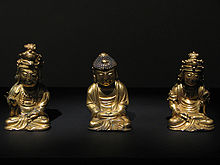 Joseon Dynasty figure on the left makes the Karana mudrā.
Joseon Dynasty figure on the left makes the Karana mudrā.
The Karana mudrā is the mudrā which expels demons and removes obstacles such as sickness or negative thoughts. It is made by raising the index and the little finger, and folding the other fingers. It is nearly the same as the gesture known as corna in many 'western' countries, the difference is that in the Karana mudra the thumb does not hold down the middle and ring finger. (This mudrā is also known as Tarjanī mudrā; Japanese: Funnu-in, Fudō-in).
Other traditions
Further information: Sign of the CrossThe East Orthodox and Catholic sacraments and holy rites of Exorcism, creation of Holy Water, Consecration, Baptism, Eucharist and Benediction involve sacred gestures somewhat comparable with mudrā.
Martial arts and mudrā
Mudrās are arm, hand and body positions used in the traditions of Hinduism and Buddhism. The historic Buddha knew the use of mudrās and is often depicted using these ritual gestures. Various Kung Fu forms contain positions identical to these mudrās.[10]
Muromoto (2003) in discussing his experience of mudrā in relation to his martial arts training makes reference to Mikkyō, Tendai and Shingon:
One of the more curious things that I encountered in my martial arts training was the use of mudra in combative arts. Mudra (Japanese: in), for those who aren't familiar with them, are these weird hand gestures that are derived from esoteric Buddhism (mikkyo), particularly the Tendai and Shingon sects. These gestures are supposed to generate spiritual focus and power which then are manifested in some way externally.[11]
Muromoto (2003) states a lineage of mudrā in martial arts and evokes Koryū, Ryū, Kantō, Tenshin Shōden Katori Shintō-ryū, Risuke Ōtake and Donn F. Draeger:
In any case, I had known of the use of mudra in koryu ("old" martial arts) since the time I was privy to a discussion with the training master of the Tenshin Shoden Katori Shinto-ryu, Otake Risuke, and the late Donn F. Draeger. Otake sensei described some of the mudra used in his school, which is one of the oldest martial ryu still in existence in Kanto (Eastern) Japan.[11]
In relation to charting a historical tributary to mudrā within Japanese fighting culture, Muromoto (2003) incorporates Shintō, Samurai, Tokugawa government, Neo-Confucianism, Zen Buddhism, Kamakura period, Edo, Takuan and Hakuin:
The use of mudra and other aspects of mikkyo are found in many instances in many koryu, because mikkyo and Shinto were the religions of the samurai who founded those ryu that were created before the 1600s. Subsequent ryu developed after the imposition of the Tokugawa government were heavily influenced by Neo-Confucianism, and then later by Zen Buddhism. Although Zen was popularized among the warrior class in the Kamakura period, the 1300s, it did not greatly affect martial arts until the latter part of the Edo Period, with the writings of the Zen priests Takuan and Hakuin. And even at that, Edo Period (1600-1868) martial arts were equally influenced by Neo-Confucianism and even, in the latter part, mystical Shinto.[11]
Muromoto (2003) textually maps the execution of the Shutō mudrā:
Mikkyo uses mudra most often in combination with various rituals, chants and so on. One common mudra is that of the "knife hand," or shuto. The first two fingers are extended while the thumb and other fingers are clenched. If you look closely, you may see this movement subtlely hidden in some koryu kata, especially by old schools such as the Tenshin Shoden Katori Shinto-ryu, or in statues of divine Buddhist beings. This represents the sword of enlightenment, which cuts away all delusions. Sometimes the tips of the extended fingers are grasped in the fist of the other hand. There is a symbolic meaning for this, derived from mikkyo.[11]
See also: Foreign influence on Chinese martial artsSee also
- List of mudras
- Tea ceremony
- Pranam
- Kāmamudrā
Notes
- ^ Encyclopædia Britannica. (2010).mudra (symbolic gestures).'.' Retrieved October 11, 2010.
- ^ Woodroffe, Sir John, Shakti and Shakta: Essays and Addresses on the Shakta Tantrashastra
- ^ Science Daily article about hand gestures and brain stimulation
- ^ Kongtrul, Jamgön (author); (English translators: Guarisco, Elio; McLeod, Ingrid) (2005). The Treasury of Knowledge (shes bya kun la khyab pa’i mdzod). Book Six, Part Four: Systems of Buddhist Tantra, The Indestructibe Way of Secret Mantra. Bolder, Colorado, USA: Snow Lion Publications. ISBN 1-55939-210-X (alk.paper) p.493
- ^ Wall Street Journal (28-07-2010). Q&A: Delhi Airport’s ‘Hands’ Sculpture.
- ^ Indian Express (26-06-2010). [http://www.indianexpress.com/news/friendly-gestures/638563/0 Friendly Gestures].
- ^ Devi, Ragini. Dance dialects of India. Motilal Banarsidass Publ., 1990. ISBN 81-208-0674-3. Pp. 43.
- ^ Barba 1991, pp. 136
- ^ For translation of jñanamudrā as "gesture of knowledge" see: Stutley 2003, p. 60.
- ^ Johnson 2000, p. 48.
- ^ a b c d Muromoto, Wayne (2003) Mudra in the Martial Arts. . Retrieved December 20, 2007.
References
- Barba, Eugenio; Savarese, Nicola (1991). A dictionary of theatre anthropology: the secret art of the performer. London, United Kingdom: Routledge. p. 136. ISBN 0415053080. http://books.google.com/books?id=31WqQLGeXRIC.
- Draeger, Donn (1980). "Esoteric Buddhism in Japanese Warriorship", in: No. 3. 'Zen and the Japanese Warrior' of the International Hoplological Society Donn F. Draeger Monograph Series. The DFD monographs are transcriptions of lectures presented by Donn Draeger in the late 1970s and early 1980s at the University of Hawaii and at seminars in Malaysia.
- Johnson, Nathan J. (2000), Barefoot Zen: The Shaolin Roots of Kung Fu and Karate, York Beach, USA: Weiser, ISBN 1578631424, http://books.google.co.uk/books?id=CtzgSZrTv64C
- Stutley, Margaret (2003), The Illustrated Dictionary of Hindu Iconography (First Indian Edition ed.), New Delhi: Munshiram Manoharlal Publishers Pvt. Ltd., ISBN 81-215-1087-2 Originally published 1985, Routledge & Kegan Paul plc, London.
Further reading
- Saunders, Ernest Dale (1985 ). Mudra: A Study of Symbolic Gestures in Japanese Buddhist Sculpture. Princeton University Press. ISBN 978-0-691-01866-9.
- Hirschi, Gertrud. Mudras: Yoga in Your Hands.
External links
- Mudras in Indian Dance
- Mudras photo gallery
- Mudras in the Buddhist tradition
- About mudras
- Mudras from Rigpa Wiki
Gestures Friendly gestures Air kiss · A-ok · Cheek kissing · Dap greeting · Elbow bump · Eskimo kissing · Fist bump · Hat tip · High five · Hongi · ILY sign · Namaste · Sign of the horns · Shaka · Thumbs signal · WaiFormal gestures Salutes Bellamy salute · Nazi salute · Raised fist · Roman salute · Scout sign and salute · Three-finger salute · Two-finger salute · Vulcan salute · Zogist saluteCelebratory gestures Finger counting Obscene gestures Head motions Other gestures Air quotes · Anasyrma · Crossed fingers · Facepalm · Finger gun · Gang signal · Hand-rubbing · Jazz hands · Kuji-in · Laban sign · Loser · Mudra · Pollice verso · Puppy face · Shrug · Sign of the Cross · Varadamudra · V signRelated Categories:- Buddhist practices
- Gestures
- Hindu philosophical concepts
- Mudras
- Iconography
- Sanskrit words and phrases
- Japanese martial arts terms
- Buddhist art and culture
- Vajrayana
Wikimedia Foundation. 2010.



